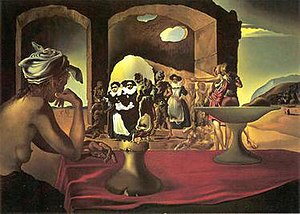Slave Market with the Disappearing Bust of Voltaire
Appearance
| Slave Market with the Disappearing Bust of Voltaire | |
|---|---|
 | |
| Artist | Salvador Dalí |
| Year | 1940 |
| Medium | Oil on canvas |
| Dimensions | 47 cm × 66 cm (18+1⁄2 in × 26 in) |
| Location | Salvador Dalí Museum, St. Petersburg, Florida |
Slave Market with the Disappearing Bust of Voltaire (1940) is a painting by Spanish Surrealist Salvador Dalí. The painting depicts a slave market, while a woman at a booth watches the people. A variety of people seem to make up the face of Voltaire, while the face seems to be positioned on an object to form a bust of Voltaire. Voltaire was a french writer and philosopher known for his opposition to slavery.
The painting was completed in 1940 in oil on canvas. Dalí describes his work on the painting "to make the abnormal look normal and the normal look abnormal."[1] He uses the technique so called "Double Image", when one form contains two or more images. [citation needed]
References
- ^ Beech, Martin (Oct 27, 2011). The Physics of Invisibility: A Story of Light and Deception. Springer Science & Business Media. p. 24.
Further reading
- Costandi, Mo. "The Ghostly Gaze and the Disappearing Bust of Voltaire". The Guardian (U.S. Edition). Monday 19 September 2011 10.48 EDT.
